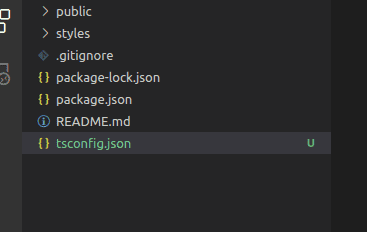Setup Next.js application with Typescript
October 28, 2020
Install Next.js app with npx
npx create-next-app hello-next
Rename javascript files to .ts and tsx
Your files that contain jsx will become .tsx and the ones with plain javascript are renamed to .ts.
- pages/api/hello.js -> hello.ts
- pages/_app.js -> _app.tsx
- pages/index.js -> index.tsx
Create tsconfig.json
In the root folder of the Nextjs application create an empty tsconfig.json:
npm install typescript support and save it as a dev dependency
- typescript
- @types/node
- @types/react
$ npm i typescript @types/node @types/react -D
+ @types/react@16.9.55
+ typescript@4.0.5
+ @types/node@14.14.6
added 5 packages from 72 contributors and audited 810 packages in 3.619s
45 packages are looking for funding
run `npm fund` for details
found 3 low severity vulnerabilities
run `npm audit fix` to fix them, or `npm audit` for detailsstartup the dev server
At this time if we look at the index.tsx file, it’s going to be all red, no problems.
Just issue npm run dev in the terminal and next will recognixe the tsconfig.json and will populate it for your Typescript base Nextjs project.
$ npm run dev
> hello-next@0.1.0 dev /home/darvat/dev/react/hello-next
> next dev
ready - started server on http://localhost:3000
We detected TypeScript in your project and created a tsconfig.json file for you.
event - compiled successfully
Attention: Next.js now collects completely anonymous telemetry regarding usage.
This information is used to shape Next.js' roadmap and prioritize features.
You can learn more, including how to opt-out if you'd not like to participate in this anonymous program, by visiting the following URL:
https://nextjs.org/telemetryYou have now converted your Nextjs project to Typescript. Check it out on the Nextjs default server port on http://localhost:3000
add _document.tsx to control the webapp’s high level layout and inject specific tags
As mentioned on the [Next.js portal(https://nextjs.org/docs/advanced-features/custom-document)]:
A custom Document is commonly used to augment your application’s <html> and <body> tags.
A very minimal _document.tsx - that must reside in /pages - is like this (just added meta description for demo purposes):
import Document, { Html, Head, Main, NextScript } from 'next/document'
class MyDocument extends Document {
render() {
return (
<Html>
<Head>
<meta name="description" content="awesome site description"/>
</Head>
<body>
<Main />
<NextScript />
</body>
</Html>
)
}
}
export default MyDocumentHope this helps.

